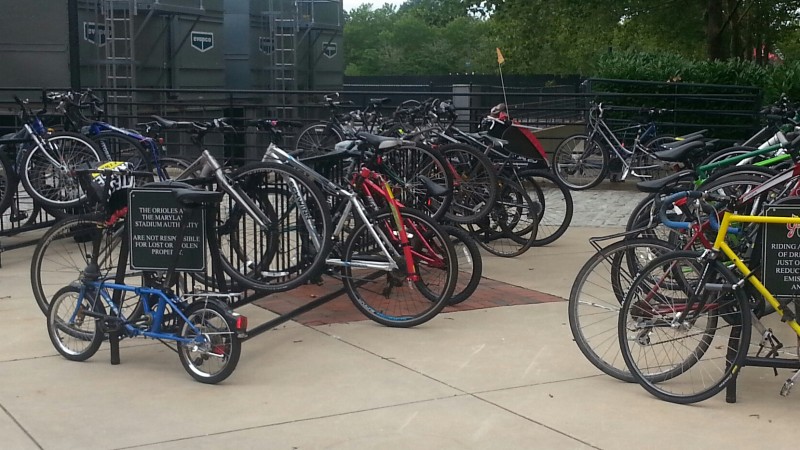Bicycles: The Red Line’s Backup Plan
By Bruce Cohen - July 2, 2015
 Red Line's "Plan B" Camden Yards stop
Red Line's "Plan B" Camden Yards stopBaltimore has experienced more than its share of misfortune these past few months. Last week, Baltimore (the region including Baltimore City and County) experienced one more generational setback when Governor Hogan announced that he would not support the Red Line. This announcement should come as a no surprise as the Governor has proven himself a man of his word by fulfilling many of his campaign promises. The Governor’s transportation platform focused on roadway infrastructure, not transit.
The Red Line’s demise continues in the tradition of Baltimore’s fragmented transportation systems. Even as the birthplace of American railroad, Baltimore’s two major rail system were disconnected. The blocks long journey between the President Street station and Camden Station lead to some of the first bloodshed of the Civil War. The city’s interstate system experienced the same disjointed development as residents of southeast Baltimore fought against the fate of West Baltimore’s Highway To Nowhere. The streetcar system, arguably the best transportation system the state has had, was privatized and replaced by a bus system, which was later state-owned and arguably became the most frustrating transportation the state has ever had. Without the Red Line, the Blue (Light Rail) and Green (Metro) lines will operate as single lines, not as a system.
In recent days, community leaders have requested that Governor Hogan reconsider his decision on the Red Line, but all indications are that this is not to be. So what is Baltimore’s backup plan for the Red Line? As multiple highway projects are announced for the remainder of the state, what does the Baltimore area stand to gain in terms of transportation projects?
The Red Line’s backup plan should be bicycles! And why not! As those who haven’t been on a bike since earning their driver’s license scoff at this answer, bicycling is a low-cost transportation mode, available to abled people of all ages without draining local, state, or federal coffers to develop.
Few barriers exist for making a quality bicycle-based system possible. The main barrier is perception. The perception that bikes are toys, and typically only toys for middle aged Caucasian men living in the suburbs. Just because something is fun, doesn’t mean it’s a toy. The reality is that more people are biking in and around Baltimore, not because it’s their weekend hobby, but because bicycling provides freedom of mobility, regardless of socio-economic status for traveling quickly and efficiently through city and suburbs at a fraction of the cost of automobile travel. These cyclists don’t catch our eye because they’re not wearing yellow spandex; they’re wearing normal clothes as they bike to work, play, or running errands.
In Bike Maryland’s transition paper for Governor Hogan, we built the argument why bicycling is good for Maryland. Not only does it bring in millions of tourist dollars each year, but has the highest return on investment for any transportation mode. The Baltimore area has been steadily improving bicycle access for nearly a decade, but with a renewed focus given the Red Line’s absence, bicycling can quickly become the best way to get around town with these few steps:
- Baltimore City is already developing separated bike facilities (barriers between bike lanes and car travel lanes) which improve safety and comfort for riders of all ages and abilities. Continue to build these bike lanes recognized in city and county bike plans throughout the region to attract interested but concerned riders.
- Rapidly institute public access bikeshare systems similar to those in Washington, DC and other cities. Bikeshare is also known as ‘the gateway drug’ to biking, providing easy access for those curious.
- With bikes come bike shops. An influx of new riders will require more local bike businesses, which create new jobs and expand the tax base. Bike co-ops can re-purpose old or impounded bikes while providing jobs training.
- Extended benefits from a quality bike system include improved air quality, improved public health through exercise, increased revenue at local businesses (as cyclists will develop excess income from limited car expenses, plus it’s easier to stop for an impulse coffee or snack when you’re going slower and don’t need to find parking!), improved and extended street quality as bikes and humans stress the street system less than cars.
- The Baltimore area will ultimately become a more attractive place to live as it becomes a more human-powered based city.
The Red Line would have enabled more people to access jobs without car access. Bicycles can do the same. Let’s move forward, shake off outdated stereotypes and create a more bikeable Baltimore for everyone!
Share
Tweet